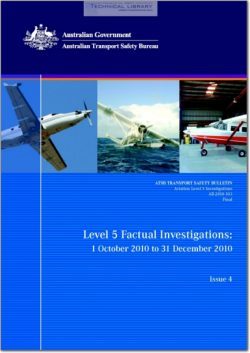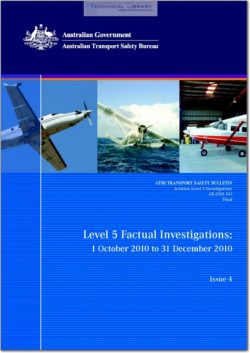ATSB-AB-2010-103

- Version
- 171 Downloads
- 3.52 MB File Size
- 1 File Count
- August 8, 2016 Create Date
- August 8, 2016 Last Updated
Level 5 Factual Investigations; 1 October 2010 to 31 December 2010 - Issue 4

On 24 August 2010, a Boeing Aircraft Company
737—700 aircraft, registered VH—VBR, was being
operated on a scheduled passenger flight from
Sydney, New South Wales to Melbourne, Victoria,
with six crew and 131 passengers onboard. The
training captain (the pilot in command (PIC)) was the
pilot flying, while the copilot was the pilot
monitoring. The copilot was undergoing line training
and had about two weeks of training left prior to his
line check.
During the descent into Melbourne, the aircraft was
held for about 10 minutes, due to a squall line1
within the vicinity of the Melbourne VORQ.
While conducting the VOR approach for runway 34,
the PIC reported that the aircraft encountered rain,
but the runway remained in sight. At that time, the
aircraft’s calibrated airspeed (CAS) was about
152 kts, the landing gear was in the down position
and 30 degrees of flap was selected.
At about 900 ft, he stated that the aircraft’s
airspeed increased by about 20 kts, but the flap
load relief did not activate. Shortly after, the crew
received a windshear alert from the ground
proximity warning system (GPWS). The crew
immediately initiated a missed approach in
accordance with operator’s windshear escape
manoeuvre and applied take—off/go—around engine
thrust. During the manoeuvre, the PIC observed the
‘PULL UP’ alert activate for about 1 second on the
primary flight display (PFD).
As the crew was visual and a positive rate of climb
established, the copilot believed that the windshear
escape manoeuvre had been completed and the
normal go-around procedure had been commenced.
Consequently, the copilot selected 15 degrees of
flap, the setting used when conducting a go-around,
and queried whether the aircraft’s landing gear
should be retracted.
The aircraft was climbed to 5,000 ft and an
approach and landing on runway 27 was conducted
without further incident. After landing, the PIC
reported the windshear occurrence and possible
flap overspeed to the maintenance engineers. An
inspection of the leading and trailing edge flaps was
carried out with nil defects found.
| File | Action |
|---|---|
| ATSB-AB-2010-103 Level 5 Factual Investigations; 1 October 2010 to 31 December 2010 - Issue 4.pdf | Download |

Comment On This Post